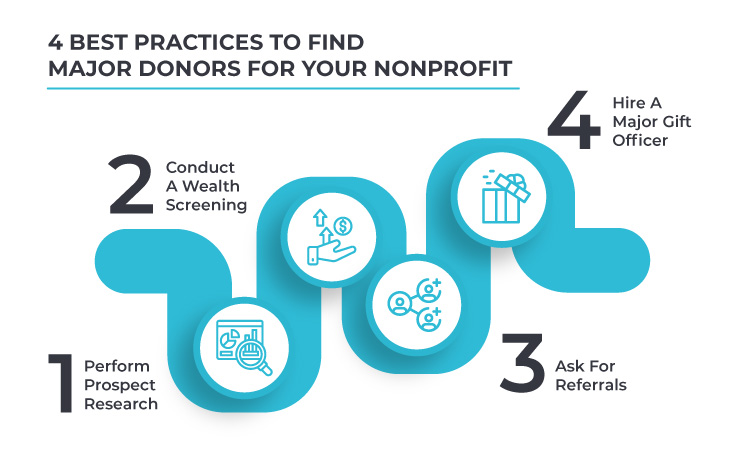our blog
4 Best Practices to Find Major Donors for Your Nonprofit
Major donors often account for the bulk of a nonprofit’s fundraising revenue, with an overwhelming 88% of funds raised coming from only 12% of donors. As a result, most organizations allocate a significant portion of their time, attention, and resources to reaching out to and cultivating relationships with major donors.
The best way to construct your major donor approach is by putting data at the forefront. With a clean, updated database, you can spend less time bringing new donors into the fold and more time making informed decisions about how to best steward their long-term support.
In this guide, we’ll explore four data-driven strategies for conducting major donor research so your nonprofit can secure the funds needed to advance your mission.
Let’s get started!


Prospect research involves gathering information to determine which donors are most likely to contribute significant funds to your organization. To begin the prospect research process, pay special attention to the following donor data points:
- Giving history: Consider the frequency and size of a donor’s recent contributions. Your most promising candidates are likely to be mid-level donors who have the capacity to increase their level of giving.
- Involvement: Past giving isn’t the only indicator that an individual is willing or able to make a major gift. Other forms of engagement—such as advocacy work, volunteerism, and board membership—can prove that a donor wants to deepen their involvement with your organization.
- Personal information: Learn more about your donors’ hobbies and interests outside of your organization. For instance, do they donate to other similar causes or volunteer in their free time? Having this information can help you to determine if they are philanthropically minded.
If your database is missing any of this information, consider investing in a data append service. AlumniFinder defines a data append as the process of using a third-party source to supplement your nonprofit’s records.
With a data append, you can paint a complete picture of your major donor prospects and make more informed outreach decisions. For example, you might conduct a mailing address append to segment prospects based on their geographic location and send in-person event invitations to those near your organization.

An important part of prospect research is conducting a wealth screening to ensure potential donors have the financial propensity to become major donors. Wealth screening tools leverage public records, philanthropic databases, and data-driven algorithms to collect information about an individual’s:
- Business Affiliations: With a wealth screening, you can learn more about donors’ careers, employers, and salaries.
- Stock Ownership: Stock ownership can point to a donor’s giving capacity, and donors can also contribute donations of stocks and securities to your nonprofit.
- Home Value: Homeowners with over $2 million in real estate are 17 times more likely to donate to nonprofits than others, indicating a strong relationship between home value and giving propensity.
Once you gain more insight into a prospect’s capacity to give, you can set realistic fundraising goals and craft a solicitation strategy that will properly engage them.

Your nonprofit likely already has a variety of connections that can help you find major donors. An introduction from a mutual contact establishes trust in your organization for potential major donors before you even begin the solicitation and cultivation process.
Consider asking the following people to introduce you to their network of business partners, peers, and vendors:
- Corporate Sponsors: If your nonprofit is looking to acquire corporate sponsors, 360MatchPro recommends creating a sponsorship web page and conducting thorough research to find companies that align with your nonprofit’s values. Then, ask them if they have any employees, leadership members, or other contacts who would be promising major donor candidates.
- Board Members: Your board sponsors are already committed to helping your organization maximize its revenue and achieve its mission. They’ll likely be willing to tap into their networks and leverage their personal and professional connections who might be interested in lending their support.
- Leadership Members: The top executives at your organization have likely built extensive relationships with philanthropic individuals and organizations over the years. Consider having them create and regularly update a list of top major donor prospects.
- Other Major Donors: What better way to acquire new major donors than with the help of your current ones? Your nonprofit’s major donors can spread the word about your organization and call upon like-minded individuals to contribute.

Major donor acquisition is an involved process that requires adequate time and attention. That’s why it’s useful to delegate responsibilities to a dedicated major gift officer.
A major gift officer should have extensive fundraising experience and a passion for your nonprofit’s cause. This role may go to an existing member of your team or an outside hire. Regardless, their support can help take your acquisition efforts to a new level by:
- Managing Your Major Gift Goals: An officer’s first task should be determining your organization’s major gift threshold and setting clear goals, such as acquiring a certain number of major donors during a fiscal year. Follow the SMART goal framework (Specific, Measurable, Achievable, Relevant, and Time-Bound) so that you can easily define goal success.
- Identifying Major Gift Prospects: Give your major gift officer access to your donor database so they can flag supporters who have the willingness and capacity to contribute a major gift. Train them in the specific major donor indicators we’ve discussed to help them pinpoint what to look for.
- Building a Solicitation and Stewardship Strategy: A major gift officer will know the best approach for soliciting major gifts, including how to appeal to a prospect’s interests and maintain their continued support with a dedicated stewardship plan.
Once your nonprofit has identified a solid list of prospects, you can map out a cultivation plan. Develop relationships with major donors through strategic outreach, meetings, and events. In the end, you should have a reliable pool of donors who can drive meaningful support to your cause.
Learn more about how Charity Dynamics can help increase your outreach and fundraising potential

